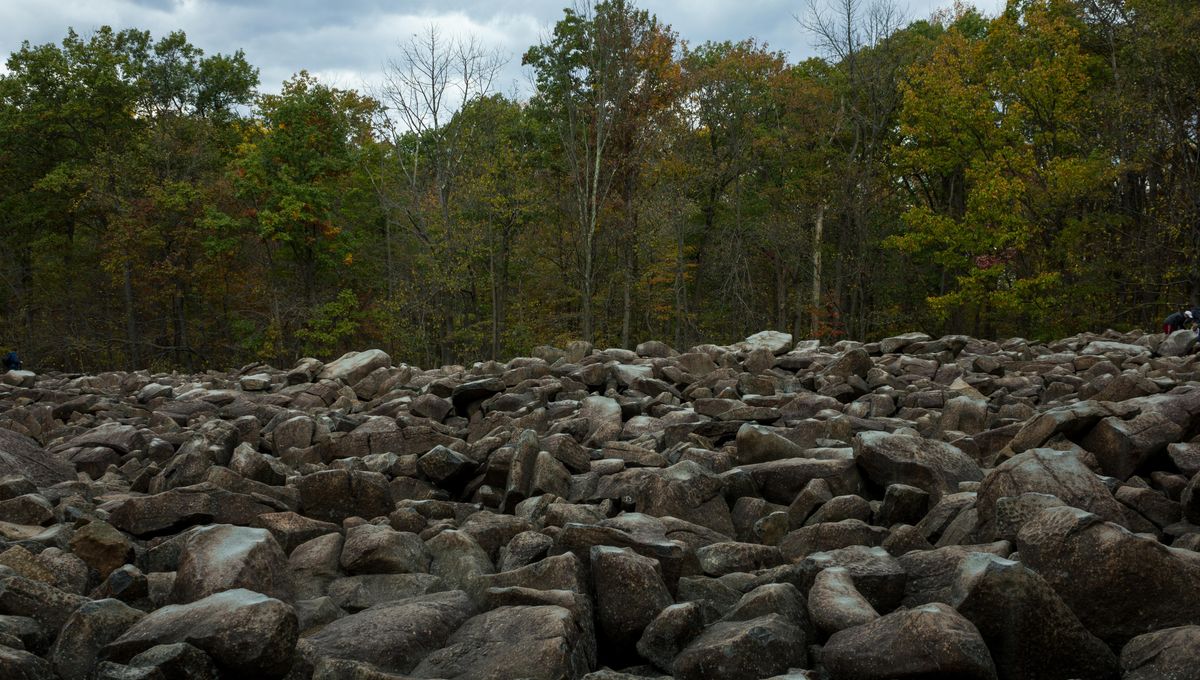
There is a place in Pennsylvania where rocks don’t just do what every other rock does. No, they’re not so pedestrian, these rocks are special: they produce a mysterious metallic bell-like sound when struck. This odd phenomenon is so famous that it has given the whole area its name: Ringing Rocks Park.
The 128-acre park is located in Upper Black Eddy in Bucks County, Pennsylvania. It is known for its serene and beautiful landscape and lush woodlands – but its main attraction is the roughly 8-acre field of large boulders that brings visitors from near and far.
There is a general mystique surrounding these singing stones, not least because it’s not completely clear why they make such noises. However, this does not mean they are magical in any way. In fact, this class of rock even has a name – lithophonic or sonorous rock – even if the exact cause of their ringing is unclear.
The rocks mostly consist of diabase, a volcanic rock with the same mineral composition as basalt, which is pretty dense with a fine-grained structure. They came to be due to “Molten lava moving up and oozing between layers of rock, then cooling over years and years,” Ronald Sloto, curator of the West Chester University mineral collection who has studied the rocks, told Rock & Gem Magazine. “When the diabase cooled, it cracked.”
According to Geology Science, the rocks’ structure may be the cause of their musical quality. The rocks at the Park have apparently undergone a process of “columnar jointing”, a natural process associated with some of the most beautiful aspects of lava flows and other volcanic deposits in nature. Columnar jointing involves sets of regularly spaced parallel fractures – joints – that form hexagonal patterns of upright stone pillars.
It has been suggested that, due to this jointing and the even structure of the diabase rocks, sound waves move through the rocks with minimal energy loss. When struck, the rocks will resonate at specific frequencies, with clear tones and a pitch that depends on their overall size and shape. However, rock arrangement on the boulder field has also been theorized to play an important role in the sounds they produce.
But this is just one interpretation. The exact cause of this phenomenon is strangely (and frustratingly) contentious despite its popularity as a feature of the Park. What’s more, there has been remarkably little actual scientific experimentation to test various ideas.
The only exception to this is a study produced over five decades ago that linked their ringing ability to the surrounding environment. In 1970, the geologists John Gibbons and Steven Schlossman published an article in the American Museum of Natural History’s Natural History Magazine that outlined the results of their analysis of the crystal formations in Bucks County rocks that rang, and those nearby that did not.
They noted that the surrounding site had its own microclimatic variations related to sun and shade that produced different levels of weathering on the stones. Those rocks in the exposed parts of the boulder field experienced different weathering factors that turned the pyroxene minerals on the surface of the rocks into a type of clay called montmorillonite. They suggested that changes altered the volume of the rocks, with an expansion of the rock’s outer shell adding more tension to its core, with this strain raising its overall resonance frequency from a “natural” level to that observed when the rocks are struck.
But while this explanation sounds good at first glance, it has been challenged by others. Firstly, there is a need to test the results here. Although it is possible that the ringing is the product of internal stresses within the rocks, the idea that they were formed due to weathering conditions has been regarded as less easy to swallow. It seems unlikely that the development of a thin skin around the rocks and boulders is sufficient to create the changes needed to create the kind of stresses mentioned here. Not least because weathering would be more apparent on exposed parts of the rock and would not necessarily be balanced, leading to more unbalancing.
To be sure, the rocks from Ringing Rock Park are not the only sonorous stones in the world, but they are still special. So will someone please test some of these explanations in the laboratory so we can finally understand why they sing!?
Source Link: Ringing Rocks Park: What Makes These Rocks Sing?